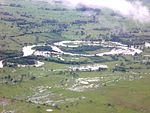This article lists the sites registered with World Heritage in Colombia.
Understand
Listing
| Site | Type | Criterion | Description | Drawing | |||||||||||||||||||||
|---|---|---|---|---|---|---|---|---|---|---|---|---|---|---|---|---|---|---|---|---|---|---|---|---|---|
| 1 Santa Cruz de Mompox Historic Center | Cultural | (iv) (v) | Founded in 1540 on the banks of the Magdalena, Mompox played a key role in Spain's hold over northern South America. From XVIe to XIXe century, the city developed parallel to the river, the first street serving as dike. The historic center has preserved the harmony and integrity of its urban landscape. The majority of the buildings today retain their original function, thus offering the exceptional image of what was once a Spanish colonial city. |  | |||||||||||||||||||||
| 2 San Agustín Archaeological Park | Cultural | (iii) | In an impressive wild landscape stands the largest group of religious monuments and megalithic sculptures in South America. Deities and mythical animals are depicted with perfect mastery in styles ranging from abstraction to realism. These works of art testify to the creativity and imagination of a culture in the north of the Andes which reached its heyday in Ier to VIIIe century. |  | |||||||||||||||||||||
| Tierradentro National Archaeological Park (department of Cauca in the pacific region) | Cultural | (iii) |  | ||||||||||||||||||||||
| Colombian Coffee Cultural Landscape (in the departments of Caldas, Quindío and Risaralda in Andean region of Colombia, and that of Valle del Cauca in pacific region) | Cultural | (v) (vi) | | ||||||||||||||||||||||
| Port, fortresses and monumental complex of Cartagena | Cultural | (iv) (vi) |  | ||||||||||||||||||||||
| Qhapaq Ñan, Andean road network crosses 6 countries: Colombia, Ecuador, Peru, Bolivia, Chile and Argentina. | Cultural | (ii) (iii) (iv) (vi) | This large network of communication, trade and defense routes covers more than 30,000 km. Built by the Incas over several centuries and partly based on a pre-Inca infrastructure, this extraordinary network crossing one of the most difficult geographical terrains in the world connects the snow-capped peaks of the Andes (at more than 6,000 m) to the coast passing through by tropical rainforests, fertile valleys and deserts. The Qhapac Ñan which reached its maximum extension in the XVe century spanned the length and breadth of the Andes. The property comprises 273 individual sites spanning over 6,000 km. They were chosen to illustrate the architectural, technical, political, social achievements of the network as well as its associated infrastructure, intended for trade, accommodation and storage of goods, and sites of religious importance. |  | |||||||||||||||||||||
| 3 Los Katíos National Park (north of Chocó in the pacific region at the border of Panama) | Natural | (ix) (x) | Covering 72,000 ha in northwestern Colombia, Los Katios Park includes low hills, forests and wet plains. It has exceptional biological diversity and serves as a habitat for several endangered animal species, as well as for many endemic plants. |  | |||||||||||||||||||||
| 4 Malpelo Fauna and Flora Sanctuary (island in thePacific Ocean To 500 km sides) | Natural | (vii) (ix) | This sanctuary is located 506 km of the Colombian coast and includes the island of Malpelo (350 ha) as well as the surrounding marine area (857,150 ha). This vast marine park, which is also the largest no-fishing area in the eastern tropical Pacific, is critically important habitat for a number of globally threatened marine species. It is also a major source of nutrients and an important aggregation area for marine biodiversity. In particular, sharks, groupers and sailfish are found here, and it is one of the few sites in the world where the ferocious odontospid, a deep-sea shark, has been confirmed. This underwater environment is widely believed to be one of the most remarkable dive sites in the world due to the extraordinary natural beauty of its steep walls and caves. In addition, these deep waters are home to large populations of large predators and pelagic species (for example, schools of more than 200 hammerhead sharks and more than 1000 silky sharks, whale sharks and tunas have been observed) which , in this undisturbed environment, retain natural behaviors. |  | |||||||||||||||||||||
Criteria legend
| |||||||||||||||||||||||||
